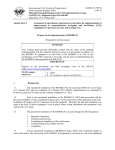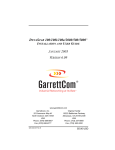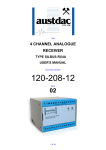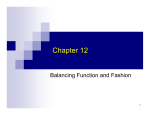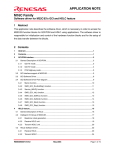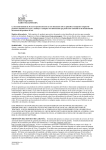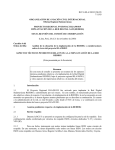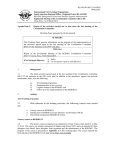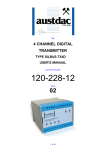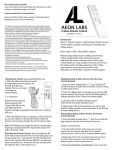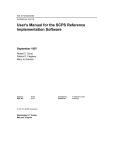Download WP04, Presented by MITRE, USA 19-Sep-2013 11:55
Transcript
International Civil Aviation Organization Sixth MEVA II / REDDIG Coordination Meeting (MR/6) Lima, Peru, 7 - 8 May 2008 Agenda Item 2: MR/6 - WP/04 28/04/08 Analysis of MEVAII/REDDIG technical and administrative management COMPLEMENTARY CONTROL AND MAINTENANCE MANAGEMENT INFORMATION TO THAT INCLUDED IN MOU (Presented by the REDDIG Administration) SUMMARY This working paper presents complementary information on control and maintenance management procedures to that specified in the MoU agreed among the MEVA II and REDDIG networks. References Memorandum of understanding between States/Territories/International Organizations members of the MEVA II and the REDDIG Project Administration. 1 Introduction 1.1 In order to satisfy aeronautical telecommunications requirements in the CAR and SAM regions effectively and efficiently, the members of MEVA II and REDDIG VSAT digital networks decided to interconnect both networks. For this purpose, members agreed to establish a Memorandum of Understanding (MoU). This agreement is established jointly under the coordination of the ICAO Regional Offices of Mexico and Lima. 1.2 The principal body of this MoU consists of four (4) sections and two (2) appendices. One of these appendices, Appendix B, refers to the technical-operational cooperation agreement for the establishment of the MEVA II and REDDIG VSAT networks interconnection. 1.3 Also, the referred Appendix B consists of 4 (four) sections: Purpose, Co-Operational Technical Process of the Agreement, Technical Terms of References and Financial Responsibilities of the Parties. 2. Information complementary to Appendix B of the MoU Terms of References for Maintenance and Control Management included in Appendix B of the MoU: 2.1 The following MoU terms of reference related to Maintenance and Control Management MR/6 – NE/04 -2are pointed out: a) Such as stipulated in paragraph 3.2.1 of Appendix B of the MoU, the interconnection implementation will not imply modifications to the technical, operational and control management of MEVA II and REDDIG networks, with the exception of necessary maintenance procedures detailed in paragraph 3.2.5 of the referred MoU Appendix B. b) Reference paragraph 3.2.2 of MoU Appendix B: Configuration, synchronization, supervision and control of additional MODEMs that participate in the interconnection and are installed in MEVA II nodes will be done by the REDDIG NCC. c) Paragraph 3.2.3 of MoU Appendix B: Band width, circuit number and type installed in the MEVA II node for communications with REDDIG will be administered by the REDDIG. . 2.2 When any problem arises in a REDDIG node with the MODEM and other equipment involved in the interconnection with the MEVA II, procedure PROC/MODEM/001, attached as Appendix to this working paper, can be applied after coordinations are done between NCCs (paragraph 3.2.5.1 of MoU Appendix B) and as part of the maintenance activities to be carried out by the local technicians of the REDDIG node. REDDIG Party financial responsibilities 2.3 Regarding MoU financial responsibilities corresponding to REDDIG members, the following can be pointed out: a) Paragraph 4.1.1 of MoU Appendix B: Additional equipment to be installed in REDDIG nodes, with requirements of the MEVA II MODEMS will be purchased by REDDIG members, according established requirements for the interconnection and necessary coordinations. b) Paragraph 4.2.1 of MoU Appendix B: Spare parts for the additional equipment to be installed in the REDDIG nodes, with the requirement of the MODEMs and other MEVA II devices, will be purchased by the REDDIG and would conform part of the spare parts of the REDDIG. c) Paragraph 4.3.1 of MoU Appendix B: Additional equipment to be installed in the REDDIG nodes that would route communications requirements with MEVA II nodes will be maintained by respective REDDIG State members under the coordination of the REDDIG Administration. 2.4 Terms of the contract for the MEVA/REDDIG interconnection implementation corresponding to REDDIG members are formulated under the above mentioned financial considerations. Procedure in case of new services and/or service configuration changes 2.5 For the agreement expressed in paragraph 4.4.3. of MoU Appendix B: “The circuits configures for communications between a MEVA II node that would have MODEMs participating in the REDDIG interconnection would be administered by the REDDIG”, and specifically for the case of new services and/or service configuration changes the procedure would be the following: MR/6 – NE/04 -3- a) The MEVA II Member should request by e-mail, through its authorized representative, the respetive requirement to the focal point of the REDDIG Administration. b) Request should contain a clear and complete description of the new services and/or service configuration change as well as the tentative date for the activation of the new service or change. c) The REDDIG Administration will respond to the MEVA II Member, after completing the feasibility analysis of not affecting operability of MEVA II and REDDIG networks, with the technical requirements that should be covered for the request activation. The REDDIG Administration, in the same way, will provide the MEVA II Member the respective quotation for the new service and / or service configuration change for its revision and acceptance. d) Once accepted the quotation by the MEVA II Member, REDDIG Administration will proceed with the implementation of the requirement according the terms stipulated in the quotation, as well as carrying out necessary coordinations with the MEVA II service supplier. REDDIG Administration focal point 2.6 In order to fulfil operation inherent activities and coordinate activities presented in the MoU, following data of the REDDIG Operation Centre and Administration focal point are indicated below: a) REDDIG Administration focal point data are: Contact: Luis Alejos Place: Manaus, Brasil Telephone: 55-92-3652 5714 REDDIG telephone: 3611 E-mail: [email protected] b) REDDIG Operation Centre data are: Place: Manaus, Brasil Telephone: 55-92-3652 5713 Fax: 55-92-3652 5712 REDDIG telephones: 3601 y 3602 Working schedule 24x365 MR/6 – NE/04 -43. Suggested actions: 3.1 The Meeting is invited to: a) take note of the information being supplied; b) analyze the information container in section 2 of this working paper; and c) propose actions and activities to complement agreements expressed in the MoU. ************** MR/6 – NE-WP/04 A-1 APÉNDICE/APPENDIX A PROC MODEM 001 MODEM LINKWAY 2100 Version 1V01 Page 1 of 3 1. GENERAL FEATURES 1.1. OBJECTIVES: Verify the correct operation of MODEM LINKWAY 2100. 1.2. PERSONNEL: The person in charge of the procedures should proceed from the staff assigned to operate and manage the Node. The minimum qualifications requirements are: a) Engineer or Technician in Telecommunications b) Knowledge of maintenance of REDDIG equipment. c) Knowledge of Windows system. 1.3. BASIC REQUIREMENTS TO PERFORM THE PROCEDURES : a) REDDIG Equipment: NMS equipment of the Station. b) Complementary equipment: Spectrum Analyzer. 1.4. REFERENCE DOCUMENTATION: a) User Manual Windows 2000. b) MODEM LINKWAY 2100 Manual. c) REDDIG Operation & Maintenance Manual (Issue B/B1) 2. PROCEDURES: 2.1. Verifying the Modem LED’s status: a) On the modem front panel, check the status of the following LED’s: Power, Sat, LO1, LO2 e ODU. Status of LED’s: Power. It should be lit. If it is off, check the fuses in the distribution board and at the rear of the unit, replace if necessary. Sat. It should be continuously lit. If it is Off: Indicates that the modem is not receiving reference bursts from the NCC. Verify, if possible, that the NCC is working (the network may be down for maintenance of the NCC). MR/6 – NE-WP/04 A-2 Check if the LNB is operating by inserting a splitter at the modem RF input connector and monitoring the satellite with a spectrum analyzer. It should be possible to see the NCC carrier bursting on carrier frequency # 1. See appendix 7.4 of Operation & Maintenance Manual for settings and frequencies. If it is Flashing: Indicates that the modem is receiving and has synchronized to the reference bursts from the NCC. It is waiting to synchronize transmissions; this will normally take less than two minutes. If the modem stays in this state, check if the SSPA/ block up-converter appears to be working, and check the cables. Switch the modem and SSPA to the dummy load and put it into the test mode to transmit a continuous modulated carrier. It should be possible to read the RF output power from the Linux M&C screen and measure the RF output power at the SSPA monitor coupler with a power meter. If there is no output, check the output of the modem with a spectrum analyzer. There should be a modulated carrier of 1.25Msym/s or 625ksym/s wide visible. If it is On: Indicates that the modem has reception and transmission synchronized. IO1: Should be lit. This indicates that the modem FRAD interface is operating and if it is lit, the Linux PC screen should also be Green. ODU: Should be off. If is lit or flashing on a new or replacement modem it indicates that the firmware or software is at a lower revision. Contact the NCC to have the latest version loaded. IO2: Should be off (the interface card is not fitted in the REDDIG system). For further diagnostics it is necessary to use the COM port access. See section 5.2. of Operation & Maintenance Manual 2.2. Verifying TDMA performance by displaying burst statistics. Access the modem by Linux PC or portable PC and use the command “cacgettxburstst”. 2.3. Verifying Frame Relay performance. Access the modem by Linux PC or portable PC and use the command “frccifstat”. The frccifstat command is sent to a terminal to display the state of the active Frame Relay interface. The command displays the status of each PVC defined on the interface. Check the state column to verify the status of the PVC: tspup—The satellite interface is functioning, but the Frame Relay interface is not functioning. ifup—The satellite interface is not functioning, but the Frame Relay interface is functioning. iftspup—The satellite interface is functioning; the Frame Relay interface is functioning, and the terminal is waiting for the other site to function. tspupconn—The PVC is ready to carry out user traffic. Access the modem by Linux PC or portable PC and use the command “prtstat hdlcID”. The prtstat hdlc(physical interface ID) command displays physical and HDLC level 2 MR/6 – NE-WP/04 A-3 statistics for an interface. Example: “prtstat hdlc0” 2.4. Verifying IP performance. (Only NCC operator) IP Performance is easily monitored using the Linkway NMS Performance Home Page window rather than the Diagnostic Testing window. 2.5. Verifying the LNB status. Access the modem by Linux PC (via Minicom) or portable PC (via HyperTerminal) and use the command “cacmodeminfo”.









